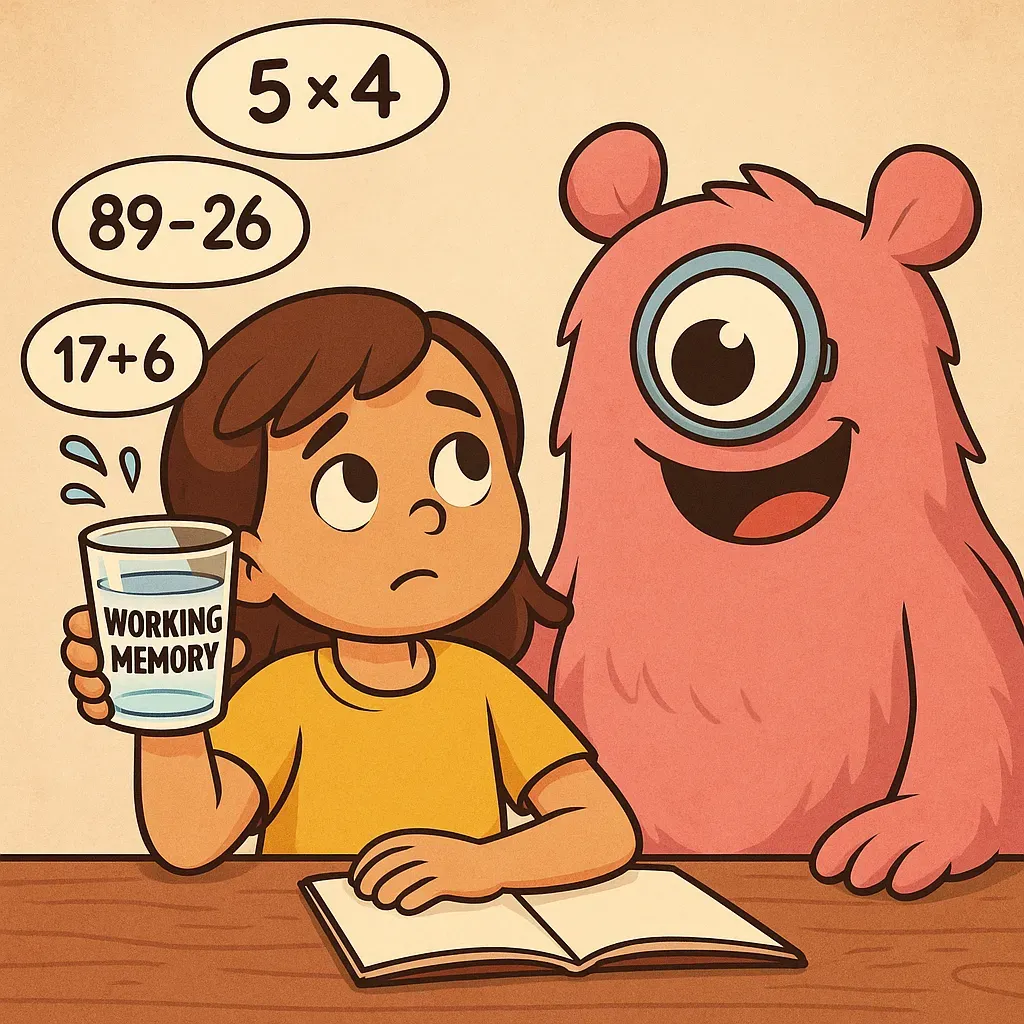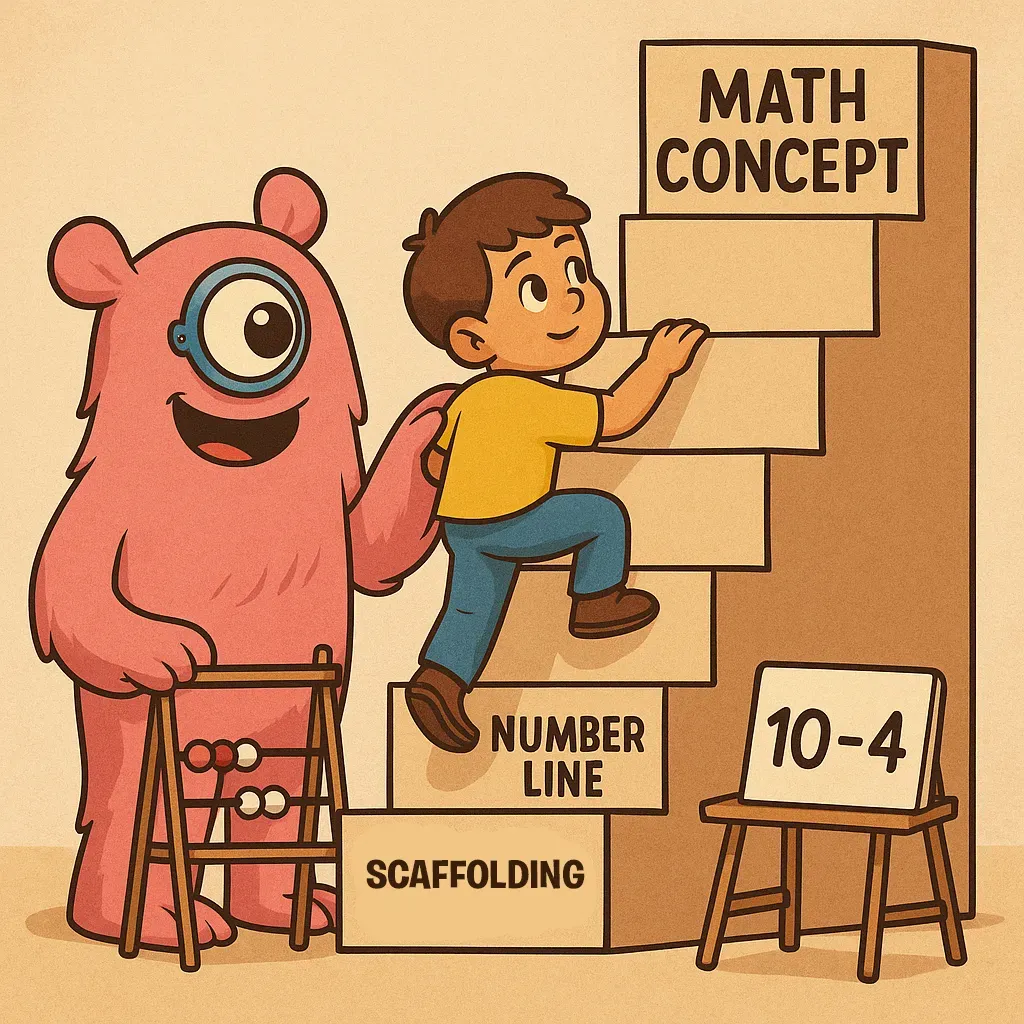How to Reduce Math Cognitive Load Without Dumbing It Down
TL;DR: To reduce cognitive load in math for young learners (without watering down the content), use scaffolding strategies like worked examples, visuals, and concrete supports; incorporate structured breaks to prevent working memory fatigue; and pace instruction thoughtfully to match attention spans and developmental readiness. These research-backed early math strategies help children engage with rigorous concepts confidently and reduce frustration - especially for those with limited working memory. Smart scaffolding and pacing don't simplify the math - they make it stick.
Math can be challenging for young learners in K–3, but there’s a big difference between making learning easier and “dumbing it down.” As parents and educators, our goal is to help children grasp complex math concepts without unnecessary confusion or overload. Cognitive Load Theory, an educational framework based on how our brains process information, offers insight into how we can do this. By reducing the cognitive load on a child’s working memory while maintaining rich content, we enable deeper learning (Sweller, van Merriënboer, & Paas, 1998). In practical terms, that means simplifying how we teach math without simplifying the math itself. Here’s how.
Understanding Cognitive Load
Working memory is limited. Cognitive scientists have found that our short-term working memory can only juggle a few pieces of new information at once. The classic estimate was about seven items (Miller, 1956), but more recent research suggests the true capacity is only around 3–5 items for about 10–20 seconds before they slip away (Cowan, 2001). Children, especially those in early elementary school, often have an even more limited working memory span; and those with neurodivergence such as ADHD could have even lesser.
This means young students can easily feel overwhelmed if we present too much information or too many steps at once.

Cognitive Load Theory divides the mental effort in learning into three types: intrinsic load, extraneous load, and germane load. Intrinsic load is the inherent complexity of the material itself – for example, adding two single-digit numbers has low intrinsic load, while multi-digit subtraction with borrowing has higher intrinsic load. Extraneous load is the mental effort imposed by how the material is presented or by unrelated factors – think of distractions, confusing instructions, or unnecessary steps that don’t directly contribute to learning. Germane load is the productive effort that actually helps form new learning – like focusing on understanding a concept or connecting it to prior knowledge.
Our aim is to reduce extraneous load and manage intrinsic load, so that most of a child’s effort can go into germane load (the actual learning) without overwhelming their working memory (Kirschner, Sweller, & Clark, 2006).
Why “Making It Easier” Isn’t the Same as Dumbing It Down
Reducing cognitive load is about clarity and support, not lowering academic expectations. We want to help children learn challenging content by presenting it in a manageable way. This doesn’t mean watering down the math concepts or skipping rich ideas. In fact, when done right, it means young learners can tackle big ideas sooner because we’re not bogging them down with avoidable confusion.
Imagine a teacher or parent introducing subtraction with regrouping (borrowing) to a 2nd grader. This concept has a high intrinsic load because it involves multiple steps and understanding place value.
- “Dumbing it down” would mean avoiding the concept entirely or oversimplifying it so much that the child isn’t doing real math – for example, only doing very simple subtraction or giving the answer away.
- In contrast, reducing cognitive load might mean using clear visuals, breaking the procedure into small steps, and guiding the child through a few examples. The child still learns how to subtract with borrowing – a complex idea – but with supports that prevent their working memory from overload.
Research backs this up: novice learners benefit from guided instruction and worked examples more than from being left to struggle on their own with minimal guidance (Kirschner et al., 2006). In other words, giving clear explanations and step-by-step help isn’t “cheating” or dumbing anything down – it’s actually a more effective way to learn new, difficult concepts. One study on math problem-solving found that students who studied step-by-step worked examples learned more efficiently than those who had to solve problems cold with no guidance (Sweller & Cooper, 1985). The content remains rigorous, but the path to learning it is made more accessible.
Strategies to Reduce Cognitive Load in Math
So how can we reduce extraneous cognitive load and manage intrinsic load when helping K–3 children with math? Here are several research-informed strategies:
- Break tasks into smaller steps. Young children can only hold a few steps in mind, so avoid multi-step instructions whenever possible. For example, instead of saying “Put away your blocks, open your workbook to page 10, and do the first five problems,” break this into one step at a time. Likewise in math, teach complex procedures in discrete phases. If a child is learning to add two-digit numbers, first ensure they can do it without carrying, then introduce carrying separately. By sequencing instruction, we decrease the load at each stage (Mayer & Moreno, 2003).
- Use clear and consistent language. Cognitive load increases when a child has to decipher complicated language or multiple terms for the same concept. Try to use simple, familiar wording and be consistent. For instance, if you’ve been using the term “take away” for subtraction, stick with it; don’t suddenly switch to “subtract” or “minus” without explanation. Clarity in language reduces extraneous mental work so kids can focus on the math idea itself.
- Leverage visuals and concrete objects – but align them tightly with the lesson. Using manipulatives like blocks or visual aids like number paths or number lines can help offload some thinking from working memory by making abstract concepts tangible. Research in multimedia learning shows that presenting information in both visual and verbal form can enhance understanding, as long as the visuals directly support the concept (Mayer & Moreno, 2003). For example, when teaching addition, showing 3 apples plus 2 apples in a picture can concretize the idea of 3+2. However, be careful: visuals that are decorative but irrelevant can actually increase cognitive load. Cute cartoons or busy graphics might distract more than they help. Every picture or object should have a clear instructional purpose, or it’s better to leave it out.
- Minimize distractions and irrelevant information. This applies to both how a problem is presented and the learning environment. In a math word problem, extraneous details can divert a child’s limited working memory. For instance, a word problem that spends a whole paragraph describing a circus before asking a simple addition question is using up mental bandwidth on the story rather than the math. Simplifying the problem to its essential elements or using straightforward contexts can reduce extraneous load. Likewise, consider the child’s environment during learning: a room full of posters, decorations, or background noise can overwhelm young children. One study found that heavily decorated classrooms caused kindergarteners to spend more time off-task and learn less compared to sparser classrooms (Fisher, Godwin, & Seltman, 2014). A clean, quiet space helps children focus their cognitive resources on the math task at hand rather than filtering out distractions.
- Connect new ideas to prior knowledge. When new material can latch onto something the child already knows, intrinsic load is effectively lowered because the child isn’t juggling entirely unfamiliar information. For example, when introducing the concept of multiplication, you might first link it to addition (“3 groups of 4 is the same as 4+4+4”). This activates existing schemas (knowledge structures in long-term memory) which reduce the burden on working memory (Sweller et al., 1998). In practice, ask guiding questions like “Have we seen a problem like this before?” or use analogies (e.g., relating fractions to familiar pie or pizza slices). These techniques encourage germane load – the mental effort of integrating new information with existing knowledge – which is the productive kind of effort that leads to learning.
- Provide step-by-step examples (worked examples). For new problem types, show a fully worked example of how to solve it. For instance, if children are learning how to solve 23 + 18, demonstrate each step (perhaps using a place value chart or drawing). The child can study the example and understand the procedure before trying it themselves. Research shows that studying worked examples is especially beneficial for novices because it reduces the extraneous load of trial-and-error and allows them to focus on understanding the procedure (Sweller & Cooper, 1985). As the child’s proficiency grows, you can gradually remove supports – a process known as “fading.” For example, next time give a partially worked problem and have the child do the next step, and eventually they’ll do it independently. This way, they experience the full problem-solving process without being overwhelmed at the start (Mayer & Moreno, 2003).
- Encourage automaticity in basic skills. One reason math gets overwhelming for children is that they’re simultaneously trying to calculate basic facts while learning a new concept. If a child hasn’t become automatic with 5 + 8 = 13, doing a more complex addition or subtraction problem (such as 15 + 18 = 33) takes much more mental effort – their working memory is tied up in simple calculations. Building fluency with basic math facts (like addition/subtraction within 10, or multiplication tables in later grades) frees up cognitive resources for the deeper aspects of a problem. This is supported by studies in educational psychology: when students can recall basic facts automatically, they solve higher-order problems more easily because their working memory isn’t overloaded (Schutte et al., 2015). You can help by practicing math facts in fun ways (flashcards, math games, quick daily quizzes, or using Monster Math) for a few minutes a day. The goal is not rote drill for its own sake, but to make foundational knowledge so second-nature that it doesn’t consume mental effort during complex tasks.
- Use scaffolding – then gradually remove it. Scaffolding means providing temporary supports to assist a learner through a task that would be too hard alone. In math, scaffolding can take many forms: guiding questions, hint prompts, visual organizers, or tools like addition charts. For example, a child struggling with multi-step word problems might use a graphic organizer that breaks the problem into “Understand, Plan, Solve, Check” sections. This externalizes some of the executive processing so the child’s mind can focus on the math reasoning. Research on learning shows that scaffolds are most effective when they target the parts of a task that cause extraneous load, and that removing them at the right time prevents dependence (Kirschner et al., 2006). Over time, as the child grows more confident and capable, you can pull away the scaffolds. For instance, stop providing the addition chart or the step-by-step checklist once you see the student can solve problems without them. The key is to support until the child has formed the necessary mental schemas to do it alone – not to permanently simplify the task.

Putting It All Together: “Simplify the Path, Not the Destination”
The overarching principle is this: simplify the learning process, not the learning goals. We want our K–3 learners to engage with rich mathematical ideas – whether it’s understanding place value, solving word problems, or exploring shapes – and feel successful doing so. By reducing unnecessary cognitive strain, we actually empower children to tackle challenging content that might otherwise feel “too hard.” They experience the satisfaction of true understanding, rather than just superficial success at an overly dumbed-down task.
As a parent or teacher, you can gauge cognitive load by observing your child’s behavior. Signs of overload include unusually quick frustration, forgetting steps or information you just went over, or abandoning a task. When you see these, ask yourself: “Is there an easier way to present this without losing what’s important?” Maybe you’ll decide to use counters or drawings to make a problem more concrete, or maybe you’ll break one big problem into a few smaller ones and have the child solve each part. These adjustments aren’t lowering the bar for learning – they’re like providing a ladder over a wall instead of expecting a child to scale it unaided.
At the same time, keep expectations high. If a concept is fundamental and valuable, find a way to teach it rather than avoiding it. Children are often capable of surprising insight and skill when taught with patience and clarity. With reduced cognitive load, a first-grader can grasp the idea of multiplication as grouping, or a second-grader can understand the logic of borrowing in subtraction. They can even tackle basic algebraic thinking or fractions in third grade without it being “over their heads,” as long as we’ve set up the lesson in an accessible way.
FAQ
How do I know if my child is experiencing cognitive overload in math?
Common signs include frustration, zoning out, or forgetting steps they just learned. If a simple task suddenly feels overwhelming, it's often a sign that working memory is maxed out. Try breaking the problem into smaller steps or taking a short brain break.
What is scaffolding in early math, and how is it different from giving the answer?
Scaffolding is temporary support that helps a child access challenging content—like hints, visuals, or guiding questions—not a shortcut to the answer. As understanding grows, the scaffolds are gradually removed, helping children become independent problem solvers.
How can teachers reduce math cognitive load in the classroom?
Teachers can break complex tasks into manageable steps, use clear visuals aligned to instruction, minimize classroom distractions, and provide worked examples. Using strategies from Cognitive Load Theory helps manage intrinsic and extraneous load while boosting germane (productive) effort.
Do brain breaks actually help kids learn better?
Yes. Short, intentional breaks help reset working memory and improve focus, especially for young children. Research shows even two-minute pauses during instruction can enhance retention and reduce fatigue, leading to better math performance.
Can using manipulatives or visuals backfire and add more confusion?
Only if they're unrelated to the concept. When used well, manipulatives like number racks or ten frames reduce mental effort by making abstract ideas concrete. Avoid overly decorative or off-topic visuals—they can increase extraneous load.
How fast should I move through math topics with my child or students?
Pacing depends on readiness. Moving too quickly risks overload; too slowly can bore learners. Watch for cues—like error patterns or disengagement—and adjust by revisiting foundational skills or offering challenge problems to deepen mastery.
In summary: Use the science of how young minds learn to your advantage. Cut out the noise and needless complexity in your math lessons and practice sessions, but keep the rigor and big ideas intact. When you do, you’ll find that children not only learn faster, but also enjoy learning more – they experience the triumph of solving a tough problem or understanding a new concept, rather than the frustration of being confused by it. By reducing cognitive load, we let their natural curiosity and reasoning skills shine through without dumbing anything down. We are simplifying the path to learning, while keeping the destination as enriching as ever.

